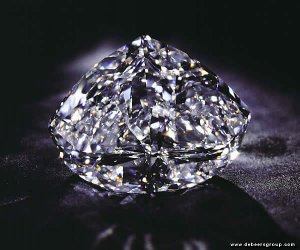
March Editorial
The Centenary in the making.

March Editorial
The Centenary in the making.
|
|
The "Centenary" is the largest modern 'fancy-cut' diamond in the world. It was mined from the Premier Mine, which is owned by De Beers Consolidated Mines. The discovery of the Centenary was a huge gift for the company's 100th year celebration in 1988, but the finished product, i.e. the cut "Centenary" was only shown for the first time three years later. As we all know, diamonds are expensive, but diamonds of the 'Centenary' calibre are in a different league altogether. While the 'Centenary' has never been publicly valuated, it was insured for over US$100 million when it was unveiled in May 1991. When the 'Centenary' was discovered (in July 1986, by use of the electric X-ray recovery system), only a handful of people knew about its existence. It was a 599 carat stone; perfect in colour. The discovery of the diamond was publicly announced in 1988 during the company's centenary celebrations, and the diamond was accordingly named "The Centenary". The stone was presented to Gabi Tolkowsky for evaluation. Gabi Tolkowsky is known in the diamond industry as one of the most accomplished cutters in the world. Indeed, his family has long been in the diamond business. Gabi Tolkowsky learned his trade from his father and and his great-uncle, Marcel Tolkowsky, diamond expert, mathematician and the author of "Diamond Design" which was published in 1919. In the book, Marcel Tolkowsky set out for, the first time, exact ways of creating the modern round brilliant cut. At the time of discovery of the "Centenary" Gabi Tolkowsky was already associated with De Beers, having been the Managing Director and Chairman of Diatrada, N.V., a division of De Beers, for over 20 years. Gabi Tolkowsky was not only asked to evaluate the diamond but also to cut it, which even the great man found a challenge. The problem was that although the diamond was perfect in almost all aspects, it was a strange shape. In its rough form it resembled an irregular cube with angular planes, a prominent elongated "horn" sticking out at one corner and a deep concave on the largest flat surface. The decision to remove the "horn" was made early on, but even with the "horn" gone, the stone presented many challenges. There were other odd shaped protrusions which needed to be taken out but the critical issue was the overall shape, which -as Tolkowsky realised from the start - would be difficult to polish. But despite the difficulties, the slightly odd shape of the stone actually presented many design possibilities for the cutter. To start with, Tolkowsky decided to use an old-fashioned technique of stone kerfing (cutting) -that is, to do it by hand. Tolkowsky chose not to use laser cutters because of the danger that the heat and vibration could damage the stone. But even before the work started, it took a year to prepare the prefect place for working with the stone. The site had to be secure, with all the necessary equipment and no external vibrations which could prove disastrous. Once the work station was prepared Tolkowsky spent time studying every groove, surface and crack of the diamond. By the time he started cutting he knew the stone by heart. It took Tolkowsky 154 days to remove 50 carats of diamond from the original stone. That completed stage one. The stone now had an oval egg-like shape and weighed approximately 520 carats. Now began the even more challenging phase of planning the final design. In all thirteen designs were presented to the board of the mining company. Tolkowsky's favourite was a heart-shaped design which he convinced the board to go with. With the design agreed, the final stage of stone cutting could start. That was in March 1990, almost four years after the original discovery of the diamond. By January the following year the "Centenary" was almost complete. The final product weighed 273.85 carats, measured 39.90 × 50.50 × 24.55 mm, and had 247 facets - 164 on the stone and 83 around its girdle. In May 1991 the stone was unveiled and loaned to the Tower of London, where it was displayed for a number of years. It is believed that De Beers no longer owns the Centenary, but the current owner is unknown. Gabi Tolkowsky, who since 1995, has been a worldwide consultant to the De Beers group, has said that he believes that the gem has been sold and De Beers declines comment, citing its anonymity policy. |
| _______________________________ | ||||
| Home | | | Shopping | | | Database |
© Biscuit Software 2004-2015
All rights reserved